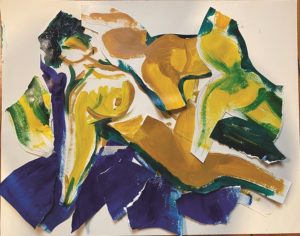It’s a Sunday morning and we’ve logged onto Zoom for “Using Color With the Figure,” taught by Laura Shabott and Alana Barrett, via the Provincetown Art Association and Museum. Introducing ourselves, we each name our favorite colors. Mine, I say, is, and always has been, red. That, Shabott said, was “a very red thing to say.”
I’ll admit to a certain obstinacy, at least when it comes to art. Growing up, I took classes at PAAM and Castle Hill. But I haven’t drawn or painted since high school. The reason, I think, is that I found making music to be less frustrating. Music is ephemeral, but making art feels too permanent. I would look back at something I had created and not like it anymore.
Maybe Shabott and Barrett’s class would adjust my attitude. I first learned about Shabott by writing an article about her for the Independent. She sees herself as part of Hans Hofmann’s lineage, through her teacher Robert Henry, and the class is offered to “artists who want to learn
Hofmann’s push/pull theory.”
I had to dig through my closet for supplies. Behind Halloween costumes and defunct science experiments, I found some old paintings that my parents had salvaged from the garbage can, as well as crusted-over acrylics, brushes, pencils, and oil pastels.
Because we don’t have good internet at home (curse you, Comcast) I took the class at my parents’ office in Wellfleet. I never found my easel, so I balanced one of those supersized clipboards on a chair. Then I just gave up and painted on the floor.
I took comfort in the fact that several of the other participants considered themselves “recovered” artists — one even used to be a musician. Shabott said that, once you are an artist, “you have it for life — it’s in your DNA.”
The first prompt was a three-minute warm-up. The model — a live nude who, yes, had her own Zoom screen — did three one-minute poses. We drew in charcoal — though I used pencil because I’d forgotten mine — then rubbed out parts, layering subsequent drawings on top of each other.

In between the prompts, we shared our work with the group by snapping a picture. This social pressure forced me to actually finish my pieces, instead of tearing them up — my usual urge.
During critiques, the artist was not supposed to say anything. This was hard for me — I’m very self-critical. How does the artist use line, form, and color? Does the blue seem to come forward, or does it recede? I listened.
The second prompt was a 20-minute exercise. Draw in charcoal or pencil, rip up the drawing, reconstruct it, then paint over it using a maximum of three colors. I realized, with much disappointment, that my red paint tube was dried out, so I used magenta instead.
“Make a problem for yourself,” our teachers suggested, opening up a 30-minute “freestyle” exercise. We might, say, employ only the color green, or use an enormous piece of paper, or make the figure look like sand dunes.
I had no trouble making problems for myself. I started painting, but my piece was terrible from the start. I threw it aside and started again. My second painting was just as bad.
With three minutes to spare, I decided to cut up my paintings (which weren’t even fully dry) and make a collage. I was on my hands and knees smearing paint all over the floor (and thankful the landlord is an artist). One minute left. I reassembled my pieces on a fresh piece of paper. There was no time to tape them down, but I took a picture. To my surprise, it looked pretty good.
People were so kind: “I love your composition,” someone said. And then, even though my piece was devoid of red, “Your colors really pop.”
